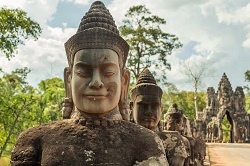Laser-equipped helicopters uncover ancient Cambodian cities
The Australian archaeologist Dr Damian Evans, funded under the CALI (Cambodian Archaeological Lidar Initiative) project, has said that the discovery could change the way in which historians and archaeologists view lost cultures and upend key assumptions about south-east Asia’s history. The findings, drawing on airborne laser scanning technology, were unveiled in full on Monday 13 June 2016 at the Royal Geographical Society in London, and have also been published in the distinguished Journal of Archaeological Science. The Angkor Wat temple complex is Cambodia’s top tourist destination and a UNESCO World Heritage Site, drawing thousands of visitors to the country each year. The complex is considered the most extensive urban settlement of pre-industrial times and possessed a highly complex irrigation system. Angkor’s decline, as part of the larger Khmer Empire, during the fifteenth century has long fascinated archaeologists. Utilising the lidar technology The newly revealed cities, ranging from 900 to 1 400 years old, are buried deep beneath the tropical forest floor, and were found by firing lasers, known as lidar, to the ground from a helicopter that produced extremely detailed imagery of the Earth’s surface. The airborne laser scanners, able to penetrate the thick jungle canopy, also identified large numbers of geometric patterns formed from earthen embankments, which Dr Evans speculates may have been gardens. In order to undertake a survey, the helicopter flies with pre-determined guidelines that include altitude, flight path and airspeed. The airborne laser scanner attached then pulses the terrain with more than 16 laser beams per square metre during the flight. The time that the laser pulse takes to return to the sensor determines the elevation of each individual data point. The data collected is then downloaded into a computer which then creates a 3D model of the information captured during the flights. To exclude manmade objects and natural foliage from the data, any sudden changes in ground height are mapped out, with technicians who have models of the terrain fine-tuning the thresholds when processing these data points. Once completed, the model is then handed over to archaeologists, who may take months to fully analyse them and convert them into maps. Understanding the ancient Khmer Empire The huge amount of new data collected by the CALI project builds on scans that were made in 2012 that confirmed the existence of Mahendraparvata, an ancient temple city near Angkor Wat. But it was only when the results of a larger survey in 2015 were analysed that the sheer scale of the new settlements became apparent. Amongst the new scans already published is a detailed map of a huge city complex surrounding the stone temple known as Preah Khan of Kompong Svay, a series of iron smelting sites dating back to the Angkor era, and new information on the complex system of waterways that kept the region irrigated. The new data also maps out the full extent of Mahendraparvata, information that will make future digs much more accurate and less time consuming. Dr Evans has confirmed that more maps of the region will be published in the coming months. One of the most striking realisations from the CALI results is that they reveal evidence of intense urban concentrations of people settled around all ancient Khmer temple complexes, thus potentially making them the largest urban connotation to exist in the twelfth century when the Khmer Empire was at its height. Following the empire’s collapse, Cambodian history is generally seen to be understood in terms of loss, retreat and absence, with the region becoming dominated by other powers. However, archaeologists and historians are now hoping to use the CALI findings of such intense urbanism to determine how far this traditional interpretation of history is accurate. Instead, this period, traditionally known as the ‘Cambodian Dark Age’, may actually have been much more diverse and lively than previously thought. Overall, experts agree that the CALI results in Cambodia are the most significant archaeological findings of recent years and the success of the lidar technology provides a valuable new tool for archaeologists seeking to better understand lost and long gone civilisations. For more information please see: project website
Countries
France



